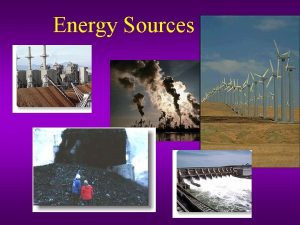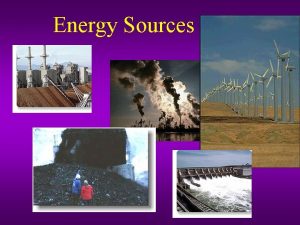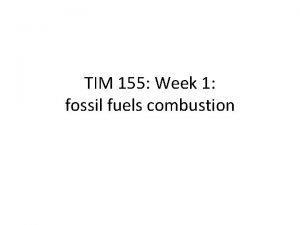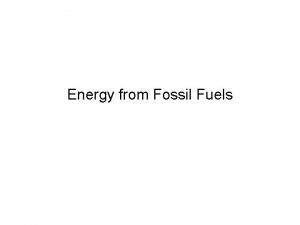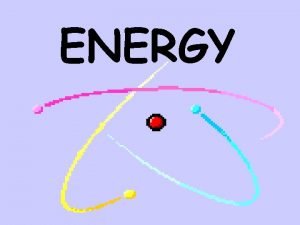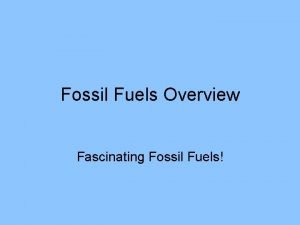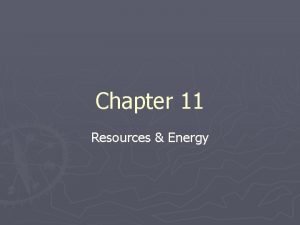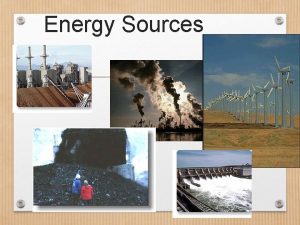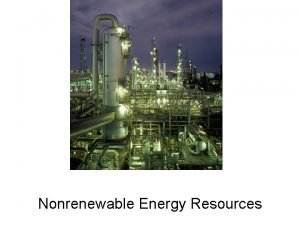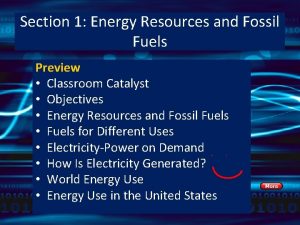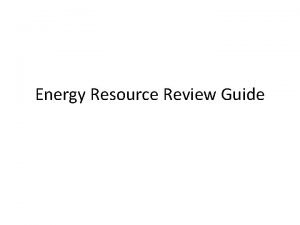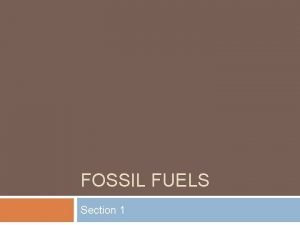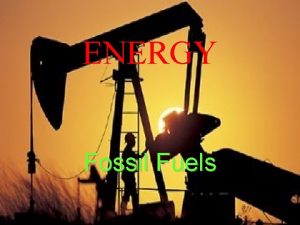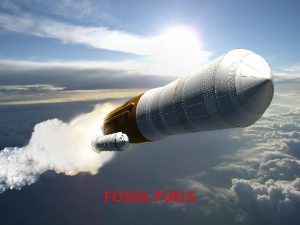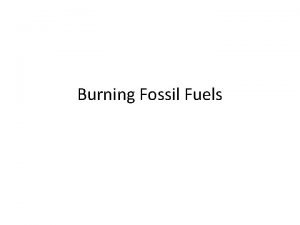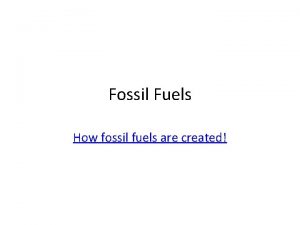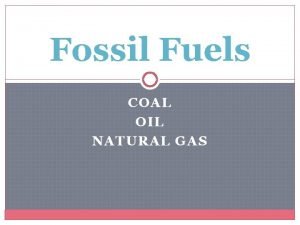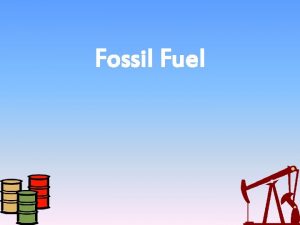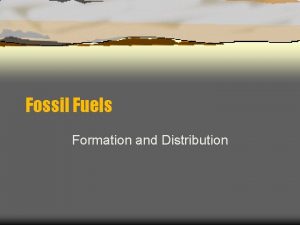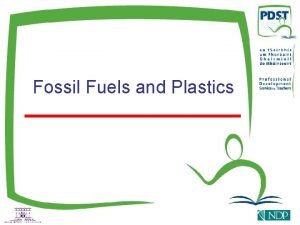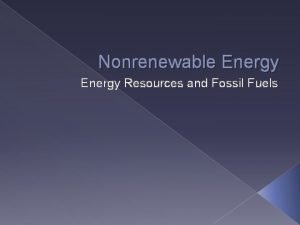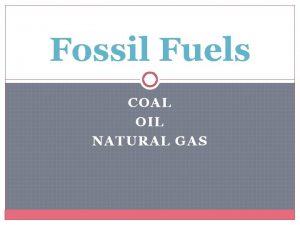TIM 155 Week 2 fossil fuels Solid fuels

















- Slides: 17

TIM 155: Week 2 – fossil fuels

Solid fuels • Peat • Coal (moisture, volatiles, fixed carbon, ash) (CH 0. 8) • Wood (moisture, volatiles, fixed carbon, ash) • Charcoal (devolatilized wood) • Coke (devolatilized coal or petroleum) • Key difference among fuels: the quantity of CO 2 formed per unit of energy released. Natural gas releases ~ 42% less CO 2 than coal

Gas and Liquid Fuels • • Natural gas: CH 4, C 2 H 6, N 2, CO 2 Propane(C 3), Butane (C 4), LPG (mixture) Synthetic gases (from biomass, coal products) Petroleum derived fuels (~CH 2); – Gasoline (C 4 to C 10, avg: C 8) – Diesel (C 12) – Turbine fuels, kerosene (C 10) – Heavy fuel oils • Shale oil derived liquids • Alcohols, ethers (have oxygen in the fuel) • Hydrogen

• Importance of fossil fuels The major contributors to Energy Use in the US and in the world Energy Supply 2010 World__ U. S. Total Energy use (Quads) 428 97 Coal (%) 33 38 Natural Gas(%) 22 26 Biomass fuels (%) 13 4 Hydropower (%) 6 4 Nuclear (%) 6 8 Solar, wind, geothermal (%) <0. 5 0. 4 Electricity Supply 2010 Net generation (TWh) Fossil fuel (%) Hydropower (%) Nuclear (%) Biomass and other (%) World 12, 500 62 19 17 5 U. S. 3, 400 68 9 20 3

Emissions By Source (2010) Note: land use means deforestation and the like. • Land use and agriculture are major contributors. Source: Stern Review, from data drawn from World Resources Institute Climate Analysis Indicators Tool (CAIT) on-line database version 3. 0

Emissions: Terms of Discussion • • Mole fraction (%, ppm, ppb) mass/energy in (pollutant/MMBtu, Kg/KJ) mass/distance (g/mile) [vehicle standards] mass/volume = g/m 3

Fossil Fuel Supply Reserves & Resources (bnboe) Yet to Find Unconventional R/P Ratio 164 yrs. R/P Ratio 41 yrs. R/P Ratio 67 yrs. Source: World Energy Assessment 2001, HIS, Wood. Mackenzie, BP Stat Review 2005, BP estimates

Things to Know About CO 2 in the Atmosphere Emissions • • Concentration The lifetime of CO 2 in the atmosphere is about 100 years A bend in the emissions graph will just delay the time that we cross the dangerous CO 2 level threshold Rule of thumb: every 10 percent reduction in emissions buys you about 7 years before reaching the max We need to reduce emissions by a factor of two from current levels to remain stable at the 550 ppm level, and this in the face of doubling the demand of energy by the middle of the century, so we need to cut the common intensity of our energy system by a factor of four

Emissions Facts • 21 st Century emissions from the Developing World (DW) will be more important than those from the Industrialized World (IW) – DW emissions growing at 2. 8% vs. IW growing at 1. 2% – DW will surpass IW during 2015 - 2020 E DW IW • • t Sobering facts – When DW ~ IW, each 10% reduction in IW emissions is compensated by < 4 years of DW growth – If China’s (or India’s) per capita emissions were those of Japan, global emissions would be 40% higher Reducing emissions is an enormous, complex challenge; technology development will play a central role

Fossil fuel combustion (chemistry) • • Coal = Carbon (C) + impurities (e. g. , sulfur) Oil = Mixture of hydrocarbons (Cx. Hy) + imp. Natural Gas = methane (CH 4) + carbon dioxide (CO 2) + imp. Combustion = oxidation, exothermic Cx. Hy + O 2 CO 2 + H 2 O + ENERGY + (CO+C) N 2 + O 2 NOx S + O 2 SOx Ratio of x: y determines ratio of CO 2: H 2 O • • CH 4 has lowest x: y and thus lowest CO 2 per energy • Carbon has the highest ratio

Chemical Structure of Coal

What happens in combustion? • Fuel + oxidizer -> Products + light + heat • Combustion, in its simplest form, e. g: methane CH 4 + 2 O 2 CO 2 + 2 H 20 A clean reaction, except for the issue of carbon dioxide and the global climate This idealized reaction takes place in an ‘atmosphere’ (oxygen) free of impurities

Real combustion • If combustion occurs without complete oxidation instead, we get: CH 4 + O 2 + N 2 mostly (CO 2 + 2 H 20 +N 2) + traces (CO + HC +NO. . . ) • This can occur when: – temperature too low, – insufficient O, – combustion too rapid, – poor mixing of fuel and air, etc. .

Even more real combustion • At higher temperatures, N reacts with O: air(N 2 +O 2) + heat NOx (thermal) • So much for pure fuels, now add impurities: enter N, S, metals and ash (non-combustibles) What we really get: • Fuel (C, H, N, S, ash) + air (N 2 +O 2) (CO 2, H 2 O, CO, NOx, SOx, VOCs, particulates) + ash – Volatile Organic Compounds: VOCs

Fuel: Data Summary q Properties of Selected Fuels CH 4 C 2 H 6 C 3 H 8 Other HCs H 2 S (wt%) Heating Value (106 J/m 3) Natural gas (No. 1) 87. 7 5. 6 2. 4 1. 8 2. 7 43. 2 Natural gas (No. 2) 88. 8 6. 4 2. 7 2. 0 0. 0004 41. 9 N O (Ultimate analysis) C H S Heating value (wt%) Gasoline (No. 2) (Proximate analysis) 86. 4 12. 7 Carbon Volatile matter (%) 0. 1 Moisture (106 J kg-1) 0. 4 -0. 7 Ash (%) (%) 45. 8 Heating value (106 J kg-1) Anthracite (PA) 77. 1 3. 8 5. 4 13. 7 27. 8 Bituminous (PA) 70. 0 20. 5 3. 3 6. 2 33. 3 Subbituminous (CO) 45. 9 30. 5 19. 6 4. 0 23. 6 Lignite (ND) 28. 2 34. 8 6. 2 16. 8 30. 8 Data from Flagan and Seinfeld, Fundamentals of Air Pollution Engineering, 1988, Prentice-Hall, and Ronneau 2004

Formation of NOx and CO in Combustion q Thermal NOx - Oxidation of atmospheric N 2 at high temperatures - Formation of thermal NOx is favorable at higher temperature q Fuel NOx - Oxidation of nitrogen compounds contained in the fuel q Formation of CO - Incomplete Combustion - Dissociation of CO 2 at high temperature 16

Summary: Combustion Products • Air, N 2, O 2, Ar • Products of complete combustion: CO 2, H 2 O • Products of incomplete combustion: trace hydrocarbons, unburned hydrocarbons, CO, H 2, aldehydes, soot • Fuel impurities: SO 2, SO, metals, metal oxides, ash (silica, sand) • Nitrogen compounds: N source is the air or the fuel, e. g. NO, NO 2, N 2 O, HONO, NH 2
 Advantage of fossil fuels
Advantage of fossil fuels Benefits of using fossil fuels
Benefits of using fossil fuels Advantages and disadvantages of fossil fuels
Advantages and disadvantages of fossil fuels Fossil fuels formula
Fossil fuels formula What are the environmental impacts of fossil fuels
What are the environmental impacts of fossil fuels Geothermal energy examples
Geothermal energy examples Fossil fuels summary
Fossil fuels summary Pros cons of biomass energy
Pros cons of biomass energy Fossil fuels
Fossil fuels Similarities between biofuels and fossil fuels
Similarities between biofuels and fossil fuels Fossil fuels summary
Fossil fuels summary Advantage of using fossil fuel
Advantage of using fossil fuel Advantage of natural gas
Advantage of natural gas Section 1 energy resources and fossil fuels answer key
Section 1 energy resources and fossil fuels answer key Fossil fuels include
Fossil fuels include Coal is a solid fossil fuel formed from plant remains
Coal is a solid fossil fuel formed from plant remains Week by week plans for documenting children's development
Week by week plans for documenting children's development Crystal solid and amorphous solid
Crystal solid and amorphous solid
